If you’re about to repot a Cymbidium (which should be done every 2-3 years), you’re probably wondering what’s the best potting medium out there. It’s almost impossible to answer that with one recipe or formula that fits everybody.
The best potting medium for Cymbidiums will depend on how much your water, what your climate is like, how old the plant is, and other variables.
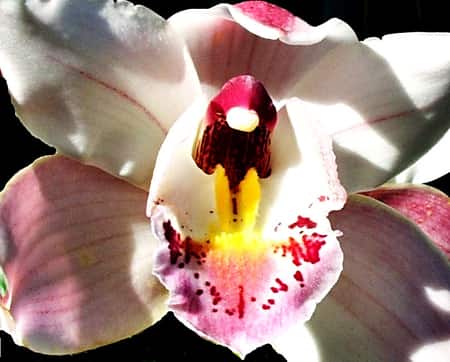
Cymbidium orchids have finer roots than most orchids it’s size. For this reason, they prefer to be potted in a medium that simulates soil.
The best potting media for Cymbidiums has to be slightly more acidic than basic, retains water more than a typical Phalaenopsis’ medium, and will still provide excellent drainage.
But for starters, the best potting medium for Cymbidiums is one that will retain water yet not become soggy. Cymbidiums are still prone to root rot despite being semi-terrestrial orchids, so the soil needs to have excellent drainage.
Because Cymbidiums are semi-terrestrial, their potting medium may be more similar to loam: a mix of sand, clay, and soil. You can make your own potting medium or buy commercially grown mediums, but don’t aim for a normal orchid medium. If you buy one, search for a specific Cymbidium Potting Mix.
In this article, I’ll show you a few options of medium formulas (or recipes) that best suits your growing needs since there isn’t one basic rule that fits all. How often you water, how dry your climate is, how big your Cymbidium is, how wide the pot is, and how old the plant is will all definitely be variables that will change the recipe for your potting medium.
Potting Mixes That Are Perfect For Cymbidiums
Before I jump into the various recipes, let’s take a look at what the different types of media there are. Each grower will have their special secrets, mixing and matching the various ingredients below.
1. Perlite
Perlite is a volcanic glass (SiO2) that was heated with extremely high temperatures to obtain a popcorn-like structure. The surface area of perlite is incredibly large, even though they are tiny white balls that look like miniature pearls.
Perlite is excellent for providing air into the potting medium and retaining water. The microscopic pores that cover the perlite increase the areas where water is absorbed. It also makes the media lighter, since a bag of perlite is extremely light.
There are various numbers or grades of perlite, ranging from P0 Micronised (which is 0.01 to 0.05mm) to P45 Supercoarse (which is 1.0 to 5.0mm).
Perlite isn’t only used in horticulture. It can be found in construction, mainly in thermal insulation, landscaping, and drainage.
2. Coir
Coir (pronounced co-YER) is the hair-like structure found on the outside of the coconut. These fibers are woven into a carpet or mat and absorb a lot of water.
In industry, coir is used to make ropes, tapestry, and doormats. Coir is most commonly found as hanging basket linings and also in bricks, which you soak, then crumble into your potting medium.
There are many names that coir goes by:
coir fiber pith,
peat (or coir-peat),
coco-peat,
and coir dust.
If you are growing Cymbidium orchid seedlings, the recommendation is that you use a little less than half the potting medium as coir.
3. Peat Moss
Peat moss is different than sphagnum moss. Peat is the old, dead material that has been compacted above the surface of the forest floor.
Different than Sphagnum, which is one specific type of moss, peat will contain anything and everything that has been compacted into the soil. This means it can include: twigs, leaves, old berries, decomposed bark, and whatever falls onto the ground.
This is the only time you’ll ever hear me promote peat moss over sphagnum moss. Since sphagnum is so much better at retaining water than peat, and is the perfect match for most orchids, I always recommend going with the best grade of Sphagnum possible. But not in this case.
Peat isslightly more acidic, and Cymbidiums prefer that. Since the rest of your potting material will already contain water retaining materials, pick the acidity over the water retention.
Peat is also less expensive than sphagnum. If you want a better look at peat moss and the differences between sphagnum moss, this article explains the finer details.Sphagnum and peat also have a downside: pests. You can check out the most common pests and insects that live in sphagnum moss in this article about Sphagnum’s Bugs.
4. Bark
Almost all orchid growers that have grown Cymbidiums once started off with bark, and over time have moved away from it. Bark is a good choice for first-time orchid growers since it will provide the proper drainage needed and gives the roots the perfect drying out time they need.
Yet, as time goes on, it’s harder to repot with bark. The bark clings to the Cymbidium roots, and makes a nasty mess that is incredibly yucky to repot. With that, many growers have moved to leca pebbles (for semi-hydroponic or hydroponics) leaving bark totally out of the picture.
Even though it is less common, try to stay away from redwood bark. It has been proven to provoke allergies and initiate respiratory illnesses. All other barks, like fir bark or pine bark, are better choices.
If you have household pets at home, check out these two articles about toxicity and orchid potting medium begin potentially poisonous to both cats and dogs. Redwood bark was the number one reason that household pets became sick (in both articles).
Anyway… Bark will come in various grades or sizes. The younger the Cymbidium, the finer the roots, which means the smaller the grade you’ll need to buy. Larger Cymbidiums will prefer larger bark pieces, since they provide more stability and drain faster.
5. Coconut Fibers/ Husks
A better solution to bark is coconut chips. These are made of the same material as coir, but cut into larger squares, imitating bark.
When compared to bark, coconut chips will degrade slower and more evenly. This translates to a potting medium that will decompose at the same rate, and you won’t risk losing roots because on part of the potting medium decomposed quicker than the other part.
The chips absorb water better than bark, releasing it slowly over time. This makes coconut chips the perfect combination for Cymbidiums, especially if you live in a drier climate.
6. Charcoal or Activated Charcoal
Charcoal or Activated Carbon has many benefits when added to your potting medium, especially for Cymbidiums. If it considered to be a natural anti-bacterial agent, not in the sense it kills bacteria, but that charcoal will remove the conditions that bacteria like to grow in.
Charcoal also excellent when it comes to the balance between water retention and proper drainage. Charcoal will absorb water to a lesser degree than coconut husks will, yet still more than other ingredients. Since charcoal is also porous, it provides air circulation inside the potting medium, enough to benefit the roots.
When buy charcoal, you can pick up a bag in your local supermarket, the same one you use to barbecue with. Just don’t buy a mix with additives, or special smells, like roasted bacon. This will do nothing for your Cymbidium. You can read more about charcoal in this article.
7. Pumice, Pebbles, River Rock, or Lava Rock
Another common type of potting medium is some form of rock. Porous or not, rocks in the potting medium will provide stability. Lava rocks and leca pebbles are a highly porous, light-weight rock that is mostly used in hydroponics. Since they absorb water, more so than the other components listed in this article, they are excellent for growing Cymbidiums.
If you use leca pebbles, try not to mix other ingredients into your potting medium. I know some orchid growers mix the two, but it becomes one gooey mess when leca pebbles are added. Most growers use leca as a drainage layer in the bottom of the pot, which is more acceptable than mixed into the potting media with other ingredients.
You’ll be aiming for a strictly hydroponic potting medium when using pebbles. You can read more on water culture in this article, but if that is the way you’re heading, you need to stop reading this current article. It will not be as beneficial to you, since all the recipes (or formulas) contain other material as well. Head over to the other article on water culture.
If don’t want to use lava rock, you can substitute for normal rocks, too. This will make your pot extremely heavy, which sometimes is a good thing.
In Kansas, famous for the tornadoes and high winds, I have to keep my pots weighed down. The traditional potting media just isn’t strong enough to keep the pots upright when the evening breezes rise. So I add a few rocks to stabilize the pots.
8. Additional Material, Such As Fertilizers
Even though this is not included in potting material, Cymbidiums need to be “heavily” fertilized (compared to other orchids). On the top layer of potting medium, you need to add some kind of additional magnesium, calcium, and lime additive. Then sprinkle the rest of the potting medium over those.
Some suggestions are: Dolomite Lime and CalMagNow that you know what is most commonly used in Cymbidium Orchids, let’s take a look at what is necessary for each climate and condition. Since Cymbidiums prefer to be outside most the year, (unless you’re blessed to live in a place that you can grow your plants outside all year long) you’ll need to analyze your climate.
Is the weather drier?
How much water will my Cymbidium be getting?
Does it rain heavily?
Can I mist each morning?
Cymbidium Medium For Dry Climates
If you live in drier climates, you’ll want to focus on a potting material that drains well, but more than that, it retains water well. Add more peat moss, coir, and perlite, focusing on smaller grade coconut husks. The larger the grade of shucks, chips, or charcoal chunks that you use, the faster the water will drain, but the faster the water will evaporate, too. So chose smaller grade items. Fine-grade bark, smaller charcoal pieces, and around 40% peat moss will do the trick.
You’ll also have to adjust your watering routine to adequately water. Check out this article about watering Cymbidiums, since it’s easy to over-water when you’re in a drier climate.
It’s not about how many times you water, but if you provide adequate watering when you water. You may think that to save your Cymbidium in a drier climate it’s best to water more frequently, but it’s best if you water more each time you water.
Again, over-watering is not adding too much water, it’s not giving your orchid adequate time to dry out in-between watering…and this is so easy to do in a drier climate.
Dry Climate Cymbidium Potting Mix Recipe
40% Small Grade Coconut Chips
20% Peat Moss
20% Perlite
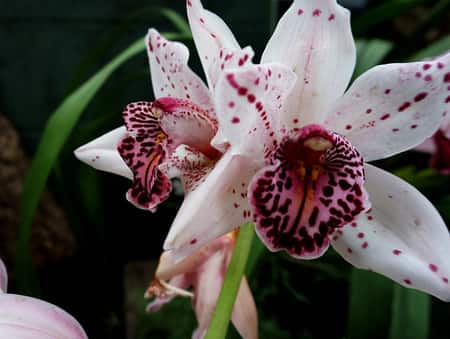
Cymbidium Potting Mix For Humid Climates
More humid climates call for a potting mix that will drain faster, more so than retain water. Remember, orchids retain water through their leaves too, so you’ll need to water less.
Chose a potting medium that has larger chunks of potting material, coarse-grade bark, less peat moss, and almost no water retention material, like sand or others.
If you add a top layer of peat moss, this helps trap in the humidity that is in the air. It’s always a temptation to think that the plants don’t need watering since it’s so humid.
This could be a trick, since loam, planters’ soil, and sand will all retain much more water than other material. But if you don’t water, then the Cymbidium can’t retain water.
Verify that you’re watering correctly, even if your climate is humid.
Humid Climate Potting Mixfor Cymbidiums
40% Coconut Husks or Fir bark
40% Perlite
10% Charcoal
10% Wood Shavings
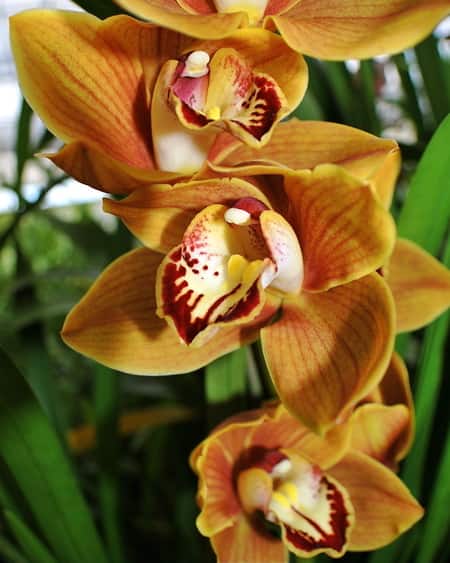
Cymbidium Potting Media For Seedlings
Seedlings will prefer mostly coir. Coir is soft enough that they’ll produce roots, yet stable enough that they’ll stand firm. You’ll also want to choose the finer grade bark, so the small, sensitive roots can find a way around the media. If the bark is too big, the roots will stop growing.
Cymbidiums Seedling Potting Mix Recipe
40% fine grade bark
20% medium grade bark
10% perlite
30% coir
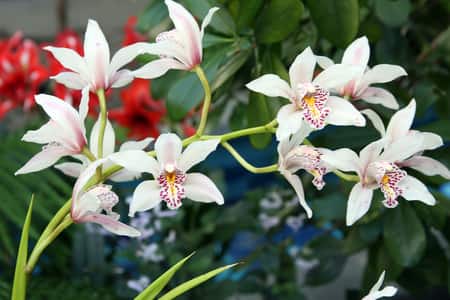
Cymbidium Potting Media For Older Orchids
Once you’ve repotted a Cymbidium, you’ll know how hard it is to clean all the nasty, old potting media from the roots. It’s a pain. That is why most orchid growers either move to hydroponics or to a media which eliminates bark all together.
I personally don’t move away from bark. Repotting can be a therapeutic process, and shouldn’t be looked upon as a chore, but as a relaxation method.
(Where do I insert the LOL?)
If you’ve seen a few YouTube videos, you’ll see that repotting a Cymbidium can be quite the workout too. Anyway… I guess it’s all in the eye of the beholder.
Anyway, for older Cymbidiums, choose the larger, coarse grade materials, that provide mega support. Large chunks of bark, with big pieces of coconut chips are the best.
Since larger pots have more roots, it’s more prone to get root rot. This is why I add bug pieces of charcoal too, adding in the prevention of bacteria. That’s another reason why it’s important to add perlite, too, aiding in air circulation.
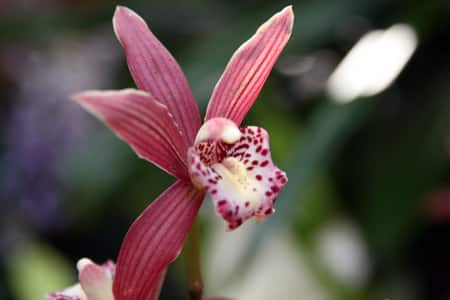
Cymbidium Potting Medium For Older Orchids
40% Large-grade fir bark
40% Coarse Coconut Chips
10% Big Charcoal Pieces
10% Perlite
Don’t Stop Learning!
If you want to be included in more information and get a 14-page fertilization guide, please sign up for my newsletter. I don’t spam, but send emails out bi-monthly with some curious topics of interest. If you want more information, click here to go to a specific page on this website where I explain it more in detail.

Also, if you are looking for an orchid journal to keep your notes specifically about orchid care, check out my 2 solutions for that on this page. If note-keeping isn’t your thing, then there is a free excel spreadsheet that you can download. Click here for more information on how to do that.
If you subscribe to my newsletter, I will send you a 14-page guide on the main tips of orchid fertilizer. It is downloadable and you can print it out on your computer. I designed the guide to double up as a coloring book, just to make it fun.
In the comments below, tell me what you’ve used as a potting media for Cymbidiums, and how it has worked for you. Remember, cultivating Cymbidiums is an art as much as it is a science. No method is perfect for everyone, but there is one that is perfect for you.
Happy Cultivating!



Like!! Thank you for publishing this awesome article.
During eight years in San Diego growing and learning about Cymbidiums, aside from finding that San Diego is the perfect environment, I settled on a mix of 40% fine fir bark, 40% redwood compost, and 20% perlite. Splitting and re-potting individual bulbs was 100% percent successful and re-potting larger clusters was not a terrible task but extremely cathartic. At the coast, they sat year-round on the south-facing porch with full morning sun and shade from noon onward. In Rancho Bernardo, they clustered on offset shelves beneath a mature jacaranda tree all day long.
Some years later, now settled in mid-elevation desert and starting all over, I suspect the need for a different potting mix and a summer indoor environment with fall through spring outdoors (or air conditioned greenhouse) with some protection for the coldest winter nights. Your discussion of potting mixes is very helpful to getting to a starting point. Going indoors with pets means dumping the redwood compost, probably in favor of fine-to-medium coconut chips and peat moss.
Question: Would an outdoor misting and fan setup allow them to make it through the summer always out of the direct sun?
Great article!
Hi Brian,
Wow, reading about your San Diego setup really painted a nostalgic visual picture. How amazing it must have been! And under the Jacaranda tree… Lovely indeed.
You’re right about the redwood. It has to go. I’d add some sphagnum moss to your mix since that will raise the absorption of humidity around the roots during extra-dry days. I think you’d also benefit from an outdoor misting system, but I’m not so sure about the fan. That would depend on how much wind you have in your area. Usually, outside you wouldn’t need one unless it’s in a greenhouse. As for indoors, you can’t get by without one.
My suggestion would be to get into an Orchid Society or gathering near you and they could tell you more about how to grow in your particular climate. It’s hard for me to recommend a specific “recipe” or “mix” because I’m not too familiar with that area, and I wouldn’t want to head you down the wrong path. The potting medium also depends a lot on your habits and routine, so your best bet would be to inquire with people from your area. They can help you more than I can.
-Amanda
Hi. I have a cymbidium, only 1 small bulb 2” tall with 4 leaves and a tiny side shoot peaking out. It has lost all roots from overwatering. I live in subtropics. At present I have it in leca with drainage holes.
Can I save it? Suggestions on how?
Hi Ruth,
Thank you for your comment. It’s hard to say if an orchid can be saved or not but I always think it’s worth a try. If it has leaves and is trying to produce a new shoot, then I’d say it’s worth the try. First you need to get rid of all the decaying material. You said it didn’t have any roots, so it’s going to have to get it’s energy with just the leaves. So make sure those are healthy and getting the right amount of sunlight. If there are any black spots still on the stem that can’t be cut off then give them a good spray with a fungicides or bactericide. It might still have enough energy to pull through. I sure wouldn’t give up on it though.
-Amanda
Hello, a great and very helpful article.
But I think something is missing or wrong percentage in the Dry Climate Cymbidium Potting Mix Recipe.
The materials only add up to 80%.
Best regards
Hi Stef,
Thank you for pointing that out! I hadn’t noticed my typo. The peat moss should be 40% and not 20% like I had posted. 🙂 I’ll go back and change that. Thanks again!
-Amanda
Iloved your conments on potting mediums,very helpful.Right now my cymbidiums are in miracle grow potting mix,not miracle grow orchid mix.Lots of grass [weeds]growing in the pots with my orchids.Should I repot my orchids in your cynbidium potting medium for older orchids?
Hi Frank,
Thank you for the comment. I can’t tell you a straight yes or or answer since I don’t know when the cymbidium was repotted the last time. If it’s just for the weeds and grass, I’d say no. It’s best to leave them for the longest time possible before repotting. They hate the change and usually set back that year.
-Amanda